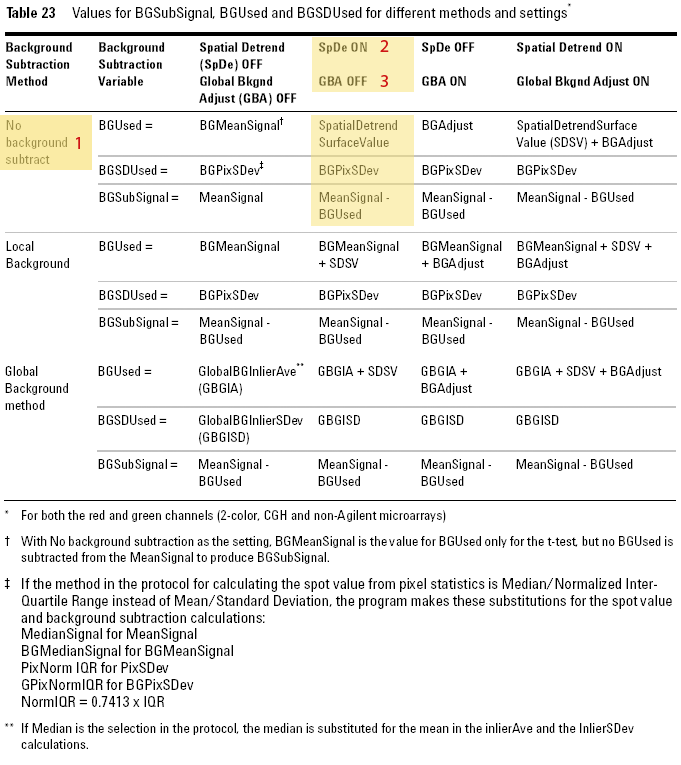
(This section is modified from Agilent Feature Extraction Software (v10.5) Reference Guide)
BGSubSignal is calculated by substracting a value called BGUsed from the feature mean signal.
BGSubSignal = MeanSignal – BGUsed
BGUsed is dependent on the type of background method and settings used in the Protocol Settings during feature extraction.
In this section we will use the default protocol settings for GE1_105_Jan09 as an example. Note that these settings could change if another protocol has been used during Feature Extraction.
Default Protocol Settings for GE1_105_Jan09

Using the default Protocol Setting for GE1_105_Jan09 we know that the data has not been background substracted (1) and that a surface fit has been calculated in order to Spatial Detrend the data (2). The data has not been background adjusted globally (3).
We can then use table 23 in the Agilent Feature Extraction Software (v10.5) Reference Guide to find how our BGSubSignal has been calculated.

From table 23 we find that BGSubSignal has been calculated by substracting the BGUsed (which is the signal that has been Spatial Detrended) from the MeanSignal.
Spatial detrending is used in order to calculate a spatial shape or surface fit for the signal intensities. According to Protocol Settings (GE1_105_Jan09) the surface fit is calculated using the FeaturesInNegativeControlRange. When calculating the surface fit the algorithm uses a moving window over the whole microarray, and attempts to choose a fixed number of datapoints for the negative controls in this window. This way the spatial detrending algorithm calculates a spatial shape (or a local background) of the whole microarray, this signal is then subtracted from the MeanSignal giving a background subtracted signal (BGSubSignal).
gProcessedSignal = BGSubSignal / MultDetrendSignal
The gProcessedSignal (Processed signal for the green channel) is calculated by dividing BGSubSignal (spatial detrended as explained in Spatial Detrended BGUsedSignal) by a MuliplicativeDetrendingSignal.
Multiplicative detrending is an algorithm designed to compensate for slight linear variations in intensities that can occur if the processing is not homogeneous across the slide.
The algorithm uses replicate probes with high signal intensities and corrects the data by fitting a smoothed surface (normalizing the replicate probes) to the array.
If the replicate probes have the same intensities, and there is no linear variations on the microarray the Multiplicative Detrending value is 1 and the gProcessedSignal will then be the same as the BGSubSignal. If the replicate probes have different intensities the Multiplicative Detrending algorithm will compensate for this and the BGSubSignal will be corrected by dividing it with the MultDetrendSignal, giving a gProcessedSignal that has been local background adjusted by Spatial Detrending and corrected for linear variations by Multiplicative Detrening.
Median raw signal calculated from the intensities of all inlier pixels that represents the feature (after outlier pixel rejection). Also called the foreground signal.
Since gProcessedSignal is the same as the BGSubSignal if the Multiplicative Detrending did not correct the data you normally would use the gProcessedSignal. Use a one-channel array plot to plot the different signal in order to find the best signal for your study. If you do not want any background substracted from your data you can use the gMedianSignal.
In this section we have explained the most commonly used Agilent signals, but Feature Extration calculates other signal as well. Use the one-channel array plot to have a look at these signals.